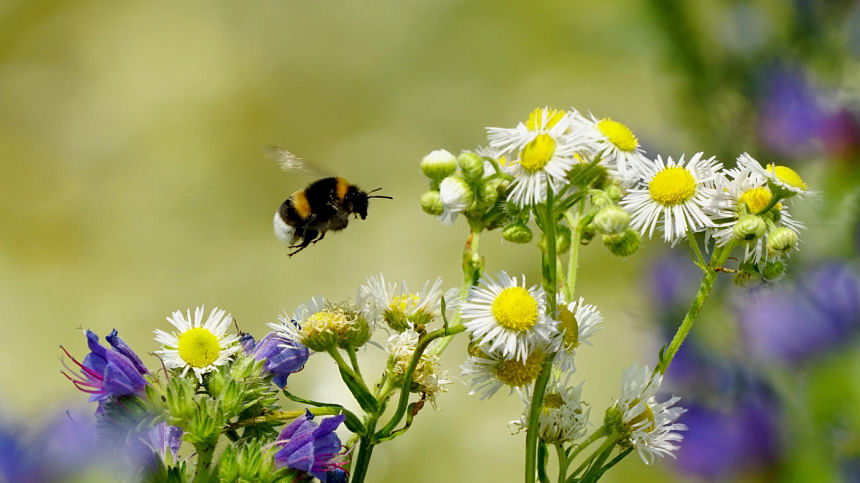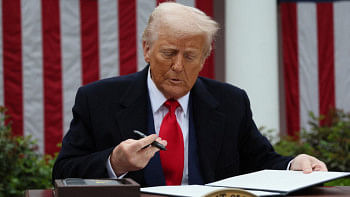The curious case of the vanishing bees: Explained

As the temperature warms and summer arrives, we expect to see the bees. For many of us, the familiar buzz by the ear is enough for a flinch or half-hearted swat, since nobody wants to pet a bee. However, what should truly unsettle us is not their presence, but their absence. Even in a place as urbanised and polluted as Dhaka, you could once spot bees in rooftop gardens or high-rise balconies. Over the years, that has become rare, and one might argue it's now not a sight at all. Strangely, we don't miss what we no longer see—but perhaps we should. While we may have grown used to their absence, that's not normal, and it is not supposed to be.
Contrary to popular belief and the Bee Movie, not all bees wear a fuzzy black-and-yellow uniform. Most people don't know this but our country holds immense potential for honey production and thriving bee environments, because we grow crops like mustard, litchi, and sesame. That's why there are so many bee species here. Species such as Apis cerana (Asian honey bee) and Apis dorsata (giant honey bee) are native pollinators in Bangladesh and are vital to our ecosystem. Most live in complex hives and work together to make honey in areas like the Sundarbans and Sylhet, an important region for natural honey production. Each bee has evolved to interact with flowers, ensuring efficient pollen spread and plant survival.
This diversity matters, because bees are more than just honey-makers. They are essential contributors to our ecosystem. According to the United Nations, nearly 75 percent of the world's food crops depend, at least in part, on pollinators like bees. From mangoes, mustard, tomatoes, tea, much of what we consume has been touched—directly or indirectly—by a bee. Beyond food, bees sustain healthy ecosystems by enabling trees, flowers, and shrubs to reproduce. These plants provide shelter, food, and stability for countless species. In essence, bees don't just help life, they also multiply it.
And they're essential to our livelihood, too. While there are other pollinators, bees are closely tied to our survival, with 20,000 species globally pollinating crops that we, humans, and other animals rely on. It's often said that if bees go extinct, so do we, because of their ecological importance.
So, if bees are this important, why are they vanishing? The reasons are different and connected. In Bangladesh, concrete has overtaken what should be green. Fields and meadows are now rare, let alone open gardens. Pesticide use in agriculture—particularly neonicotinoids and other insecticides—has proven deadly to bees, but is still widely used because it's effective. Another harmful practice in our country is monoculture farming, which focuses on one crop and limits the flower variety bees need throughout the year. All of this leads to the same result: fewer chances for bees to pollinate and survive.
But the issue extends beyond local problems. Globally, a 2025 report by the Intergovernmental Science-Policy Platform on Biodiversity and Ecosystem Services (IPBES) estimates nearly 40 percent of invertebrate pollinators, especially bees and butterflies, face extinction. Habitat loss, pollution, and parasites like the Varroa mite continue to reduce the bees that should be present.
And of course, climate change is a big contributor. As global temperatures rise, seasonal patterns behave unpredictably. Flowers bloom earlier or later than they should, creating a dangerous mismatch between pollinators and the plants they depend on. In Bangladesh, rainfall and heatwaves are disrupting floral cycles and bee habitats. Many species, cannot adapt to these unpredictable changes. And if they can't survive, how long until we find ourselves equally unadaptable?
Still, there are things we can do. On balconies or rooftops, we can plant bee-friendly flowers like mustard, basil, or fruit trees such as mango and guava. These steps benefit us too because we enjoy the fruit while promoting pollination. Avoiding chemical pesticides in home gardens is a simple yet powerful step. In Dhaka, green rooftops and vertical gardens are slowly becoming part of sustainable design, showing increased awareness of these crucial movements.
Yet, it's vital we consider the bigger picture: individual effort cannot bear the weight of an ecological crisis. The decline of bees, like climate change, is a systemic issue. We need policies that ban harmful pesticides, protect habitats, and support sustainable farming. We need community-driven urban planning that makes sense for both people and nature. Most of all, we need governments, industries, and citizens working together. Because no matter how many flowers we plant on our windowsills, they won't bloom if there's no bee to find them.
The vanishing of bees isn't a distant environmental tale, it's a local, urgent reality. And if we have what we need to change it for them, and help their reality be better, it's our responsibility to do so.
References:
1. United Nations. (n.d.). World Bee Day: 20 May
2. World Economic Forum. (2016, March). 40% of pollinator species face extinction, report finds.
Tinath Zaeba is an optimistic daydreamer, a cat mom of 5 and a student of Economics at North South University. Get in touch via [email protected].

 For all latest news, follow The Daily Star's Google News channel.
For all latest news, follow The Daily Star's Google News channel. 








Comments